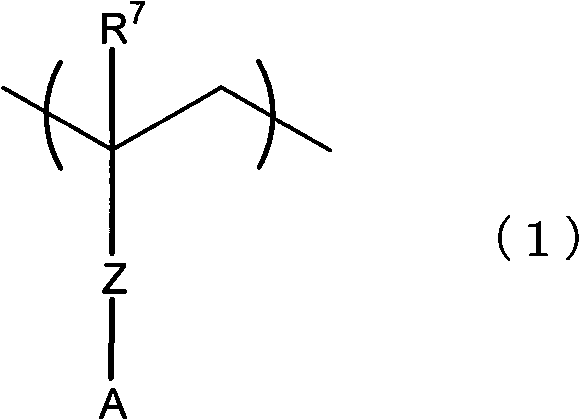Radiation-sensitive linear composition for forming coloured layer, colour filter and colour liquid crystal display device
A coloring layer and ray-sensitive technology, which is applied in the direction of nonlinear optics, instruments, optical filters, etc., can solve the problems of inability to obtain developing resistance and solvent resistance, and achieve the effect of excellent solvent resistance
- Summary
- Abstract
- Description
- Claims
- Application Information
AI Technical Summary
Problems solved by technology
Method used
Image
Examples
Synthetic example 1
[0247] In a flask equipped with a condenser and a stirrer, dissolve 70.0 g of 3-acryloyloxymethyl-3-ethyloxetane, 15.0 g of acrylic acid and 15.0 g of ω-carboxypolycaprolactone monoacrylate To 300 g of propylene glycol monomethyl ether acetate, 3.0 g of 2,2'-azobisisobutyronitrile and 5.0 g of α-methylstyrene dimer were added, and then purged with nitrogen for 15 minutes. After purging with nitrogen gas, the reaction solution was heated at 80° C. while stirring and bubbling nitrogen gas, and polymerized for 5 hours to obtain a solution containing 25% by weight of the precursor copolymer [b-1]. The polystyrene conversion weight average molecular weight (Mw) of this precursor copolymer [b-1] was 10000.
Synthetic example 2~9
[0249] Except that the types and amounts of compound (b1), compound (b2), compound (b4) and compound (b6) which are polymerizable unsaturated compounds, polymerization initiators, chain transfer agents, and molecular weight modifiers are as shown in Table 1 , were carried out in the same manner as in Synthesis Example 1 above to obtain solutions containing 25% by weight of the precursor copolymers [b-2] to [b-9].
[0250] Table 1 shows the polystyrene-equivalent weight average molecular weight (Mw) of the precursor copolymer produced in each synthesis example.
[0251]
[0252] Synthesis of polymer (B)
Synthetic example 10
[0254] 200 g of the solution containing the precursor copolymer [b-1] prepared in Synthesis Example 1 above, 25.6 g of glycidyl methacrylate as compound (b5), and 4-methoxyphenol as a polymerization inhibitor 0.2 g and 2.5 g of tetrabutylammonium bromide as a catalyst were put into the flask, and it was made to react at the temperature of 110 degreeC for 9 hours. This reaction liquid was washed with water four times with 75 g of ion-exchanged water each time, and concentrated under reduced pressure to obtain a solution containing 33% by weight of the polymer [B-1]. The polystyrene-equivalent weight average molecular weight (Mw) of polymer [B-1] was 11,500, the oxetanyl group content was 2.8 mmol / g, and the polymerizable unsaturated bond content was 1.8 mmol / g.
PUM
| Property | Measurement | Unit |
|---|---|---|
| thickness | aaaaa | aaaaa |
| thickness | aaaaa | aaaaa |
| thickness | aaaaa | aaaaa |
Abstract
Description
Claims
Application Information
 Login to View More
Login to View More - R&D
- Intellectual Property
- Life Sciences
- Materials
- Tech Scout
- Unparalleled Data Quality
- Higher Quality Content
- 60% Fewer Hallucinations
Browse by: Latest US Patents, China's latest patents, Technical Efficacy Thesaurus, Application Domain, Technology Topic, Popular Technical Reports.
© 2025 PatSnap. All rights reserved.Legal|Privacy policy|Modern Slavery Act Transparency Statement|Sitemap|About US| Contact US: help@patsnap.com



